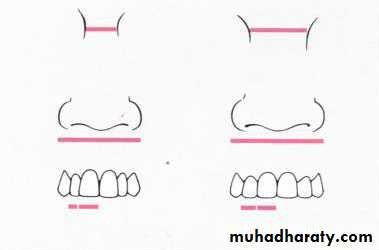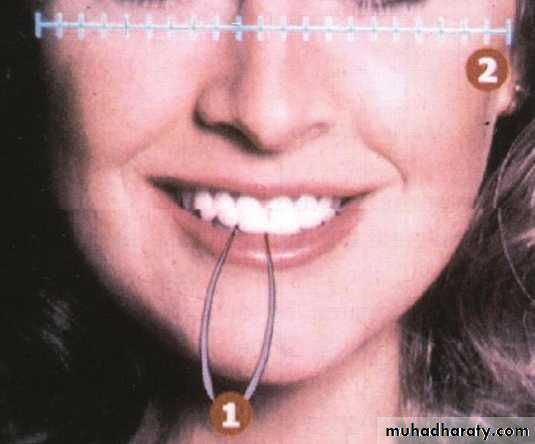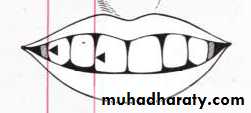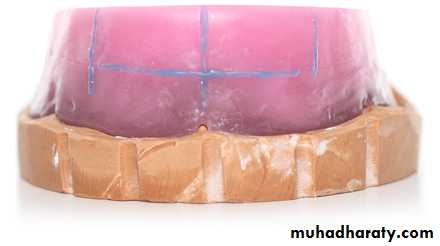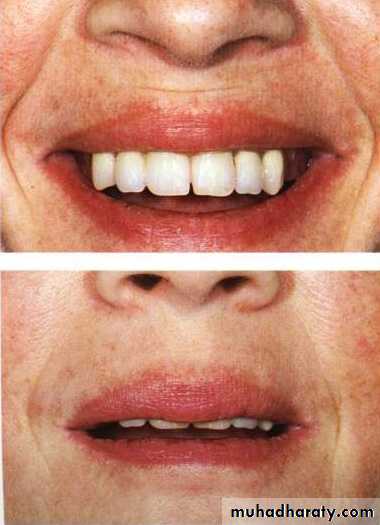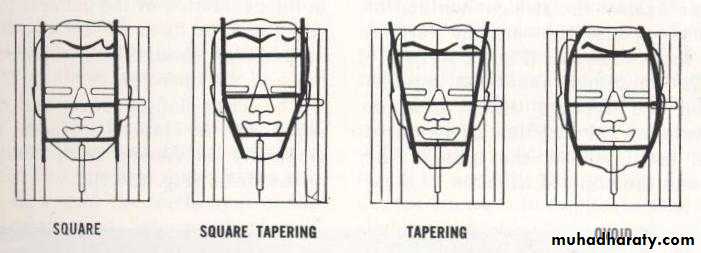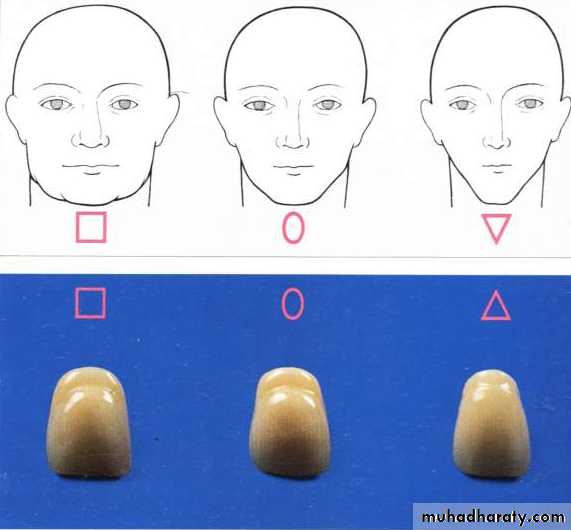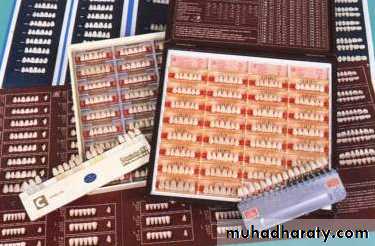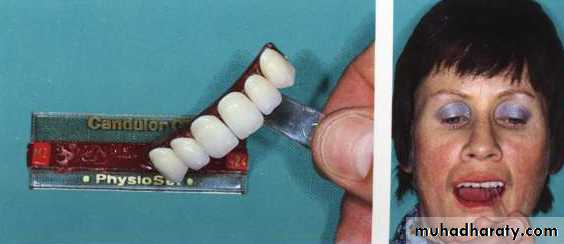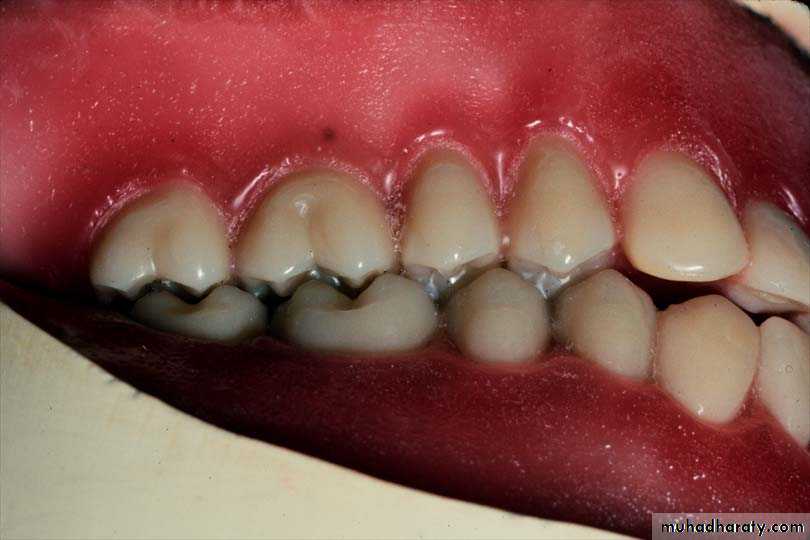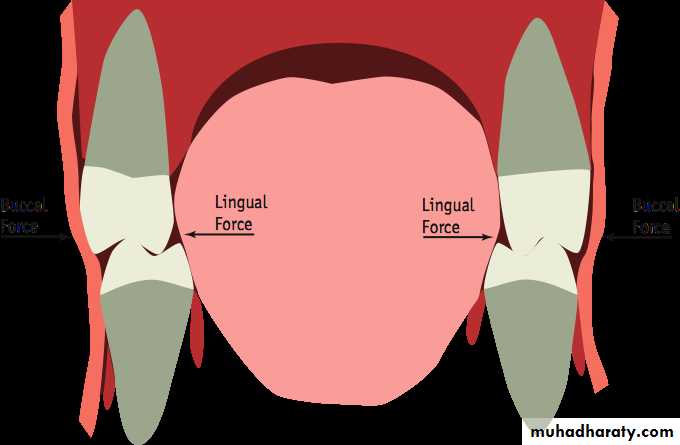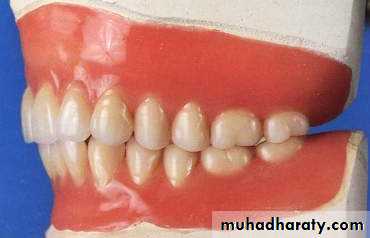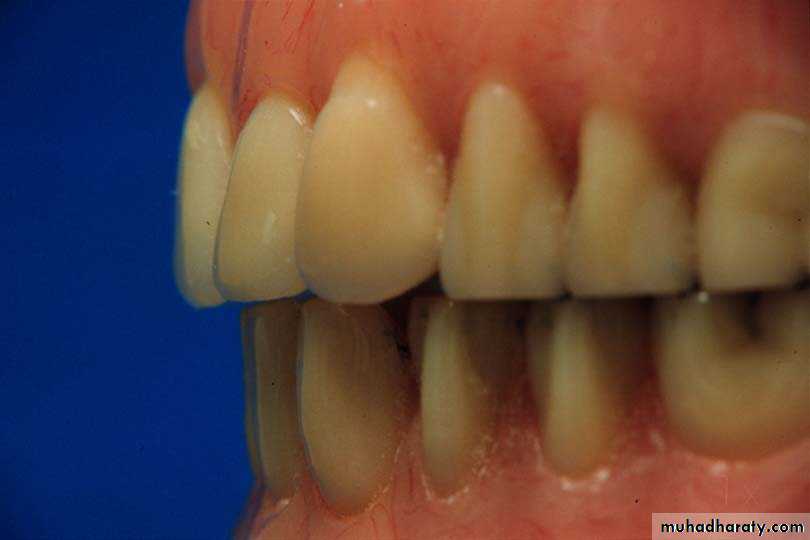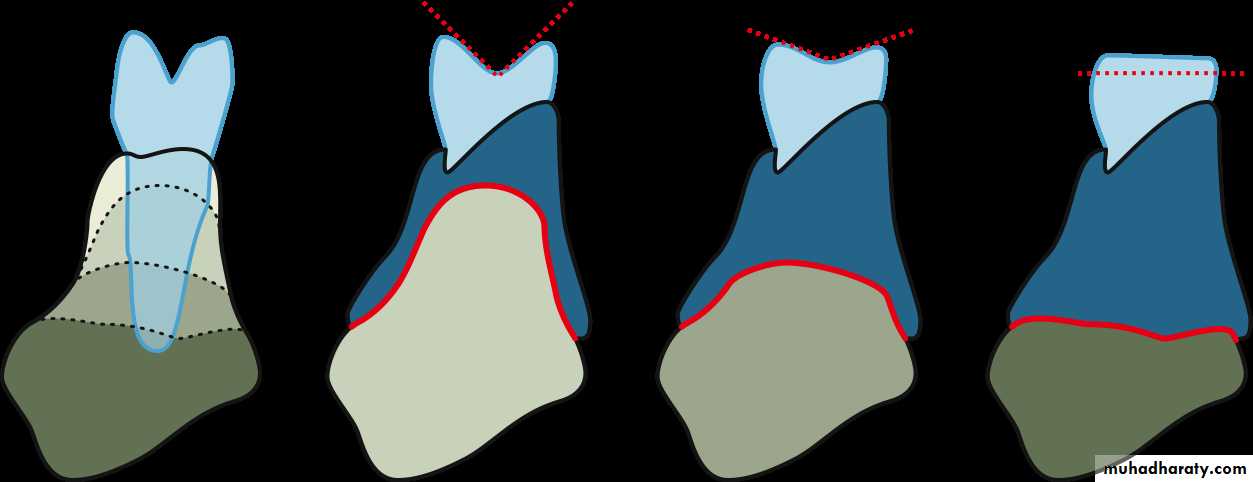Selection of Artificial Teeth for completely edentulous patients
Definition:The selection of a tooth or teeth of a shape, size and color to harmonize with the individual characteristics of a patient.
Classification of patients:
1. Patients with remaining natural teeth
2. Patients who have old denture
3. Patients without remaining natural teeth and without old denture
Objectives:
1. Esthetics2. Masticatory function
3. Correction of speech defects
4. Preservation of the remaining tissue and muscle tone
- Primary selection of the teeth must be carried out at the first appointment.
Anterior teeth selectionGuides for the anterior teeth selection:
• Pre-extraction guides
2. Post extraction guides
Extracted teeth
Old dentures of the patient
When pre and post extraction records are not available or not useful in selection of anterior teeth, then the following methods can be used:
Selection of size (width and length)
a. Size of the face and head
b. Size of the maxillary arch
c. Maxillomandibular relations
i. In class I – Normal relationship, the teeth in one arch are compatible with the teeth in the other arch.
ii. In class II – The mandible is retruded and the mandibular teeth are frequently smaller
iii. In class III – The mandible is protruded and the mandibular teeth are frequently larger than normal
Size of anterior teeth
Size of the faceWidth of maxillary central incisor = 1/16 bizygomatic width of the face
Width of the alae of the nose
If the base of the nose is wide the central incisor should be wide, if the root of the nose is narrow the lateral incisor should be narrow.Cranial circumference
Size of maxillary archNot dependant in sever resorption
Corners of the mouth
The distance measured between the two commisures (angles of the mouth ) will represent the width of the upper six anteriors from the distal surface of the canine to the distal surface of the other canine.
A mark is placed at occlusion rim at each corner of the lips when the patient is relaxed
Incisal papilla & cuspid eminences
Distance = width of six maxillary anterior teethLine drawn from the distal termination of the eminence (or anterior to buccal frenum attachment) following the contour of the ridge , reaching the anterior border of incisal papilla, then terminate distal to canine eminence of opposite side
Vertical distance between the ridges
Length of the anterior teethThe lips
Length of the anterior teeth
High lip line (when the patient smiles) : cervical third of anterior teeth
Low lip line (when the patient relaxed) : incisal third of anterior teeth
Maxillomandibular relations
Mandibular anterior teeth size & lengthRetruded mandible : the mandibular anterior teeth smaller
Protruded mandible : the face is longer the mandibular anterior teeth longer
Contour of residual ridges
Direction of resorption (HW)?
Form of anterior teeth
The form & contour of the faceSquare, taper, or ovid
Sex
Curved features = female
Square features = male
Age
Older age = outline more square
Color or shade of anterior teeth
Patients age – With age, darker, while lighter teeth are suitable for young patients.
Patients complexion—light teeth for fair skin, blue eyes, dark teeth usually for dark skin and black eyes.
The following facts are true for nearly all natural teeth:
a. The neck of the tooth has a more pronounced color than the incisive edge.• The incisive edge if not worn, is more transluscent that the body of the tooth and is usually of a bluish shade (composed entirely of enamel)
c. The upper central incisors are lightest teeth in the mouth followed by the laterals and canines. Posterior teeth are usually uniform in color.
d. Teeth darken slightly with age.
Aid for selecting the shade
Shade guides – The shade guide tooth should be moistened and selection made in the normal light.a. Outside the mouth along the side of the nose.
b. Under the lip with the incisal edge exposed
c. Under the lip with only the cervical end covered and the mouth open.
Posterior teeth Selection
Shade of posterior teethShade of posterior teeth should harmonize with the shade of anterior teeth (bicuspids)
Size & number of posterior teeth
Buccolingual widthBuccolingual width of artificial teeth less than natural teeth to reduce the size of food table but don’t lose the support for cheeks, & not great enough to embarrass the tongue or encroach on a normal buccal corridor
Anteroposterior dimensions
Anteroposterior dimensions of posterior teeth are determined by the edentulous area between the distal of canine and the maxillary tuberosity in maxillary arch and between the distal of canine and the ascending area of the mandible in mandibular arch.Why?
To place teeth on the ascending area of the mandible would direct the forces at an inclined plane, which are more dislodging than forces directed at right angles to the supportVertical height
The height of the maxillary first premolar should be comparable with that of the maxillary canines to have the proper esthetic effect
Occlusal form
Cusp angles are measured from a horizontal axis when the tooth is set with its long axis perpendicular to the horizontal axisBased on occlusal form, posterior teeth classified as:
Anatomic teeth
Semianatomic teeth
Non anatomic teeth
Special forms of teeth
Cusp form teeth ( anatomical teeth ):
Were designed for the function of mastication. Their cusps were arranged so that during closing movements they would shear & crush food when the patient applied a reasonable biting force.Indications
In well formed ridges where good support and retention can be expected.Where balanced occlusion is planned.
Patient with good neuromuscular control.
Advantages:
• Ease in developing bilateral balanced articulation between the maxillary & mandibular teeth during eccentric movements• Excellent esthetic quality
• Chewing usefulness
• Disadvantages:
• Possible damage to the supporting tissues due to deflective contacts when vertical dimension is lost through resorption
• When bone loss occur lead to denture movement , discomfort, irritation of soft tissue,& more bone loss
Monoplane teeth ( non anatomical teeth )
They were designed without cusps to allow for intercuspation anywhere along the occlusal plane anteroposteriorly.Indications
They are indicated in flat ridge cases to minimize the lateral destabilizing forces.When balanced occlusion is not planned.
In abnormal jaw relationships or when it is difficult to record centric relation as in patients with poor neuromuscular control.
Patients with cross bite tooth relations.
Patients with deleterious habits such as bruxism.
Advantages:
• Freedom in movement• Used in class II & class III jaw relation ships
• Closure of jaws over a broad contact area
• Minimal horizontal pressure
• Easier maintenance
• Fabrication of dentures with simple techniques & articulators
• Disadvantages:
• Lack of esthetic quality
• Less chewing efficiency
Material composition of teeth
Acrylic resin teethLess resistant to wear & staining
Less likely to chip or fracture
Chemical means of retention with the denture base
Used in cases of small inter arch distance. Why?
Ease of occlusal reshaping
Used in cases where the opposing teeth (natural or have metalic restorations). Why?
Porcelain teeth
More resistant to wear & staining
More likely to chip or fracture
Mechanical means of retention with the denture base
Not used in cases of small inter arch distance. Why?
No occlusal reshaping
Not used in cases where the opposing teeth (natural or have metalic restorations). Why?

